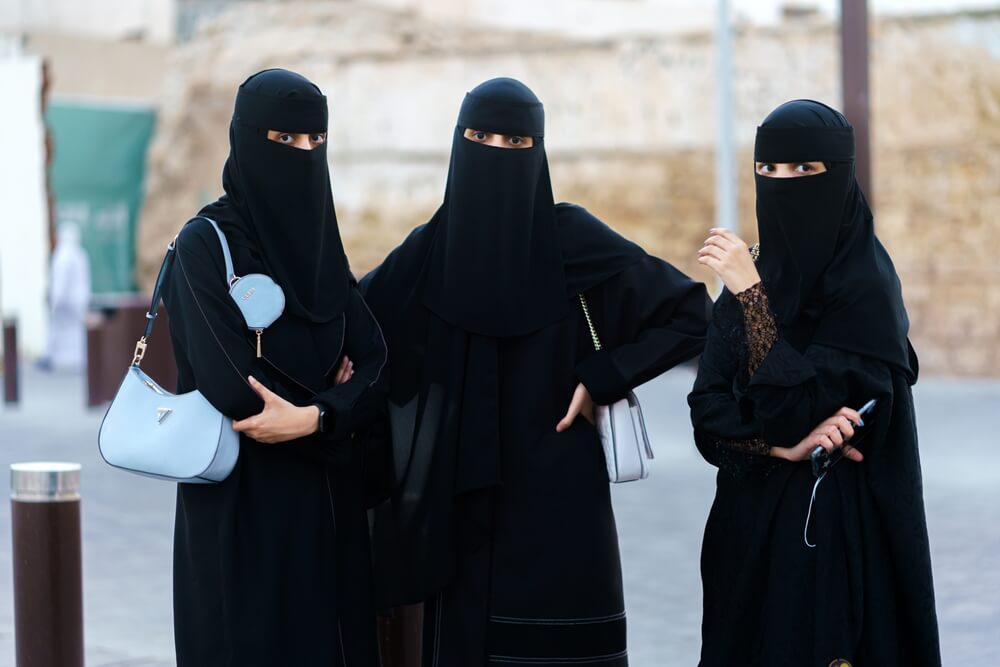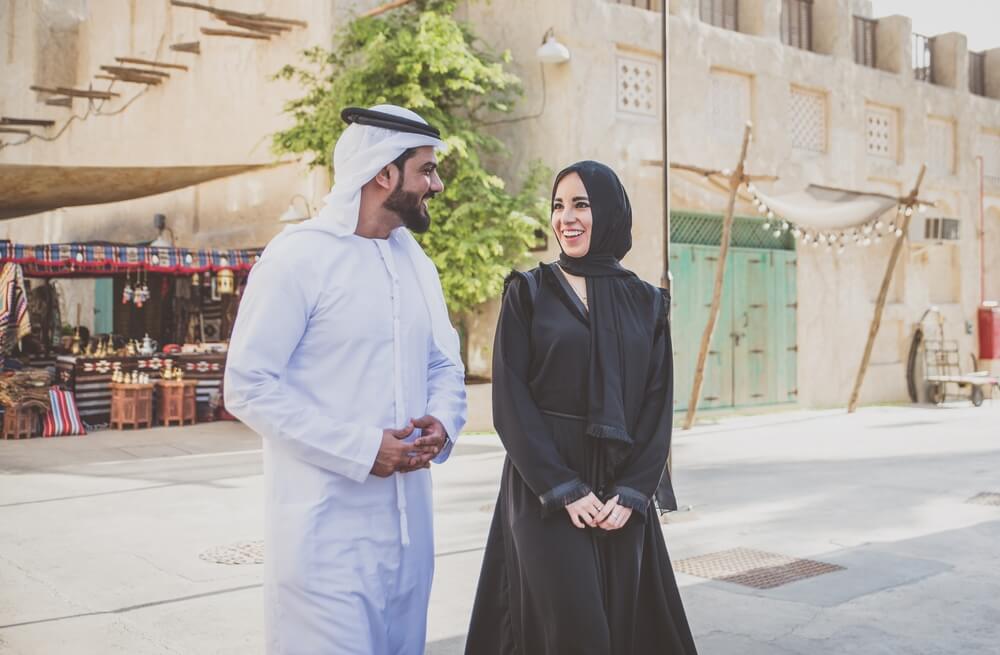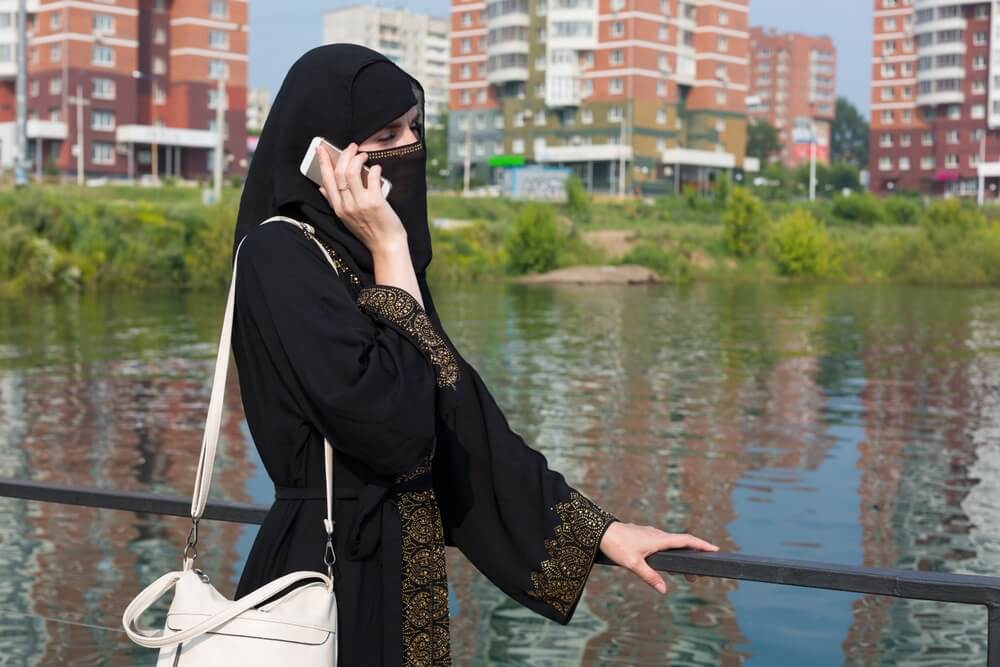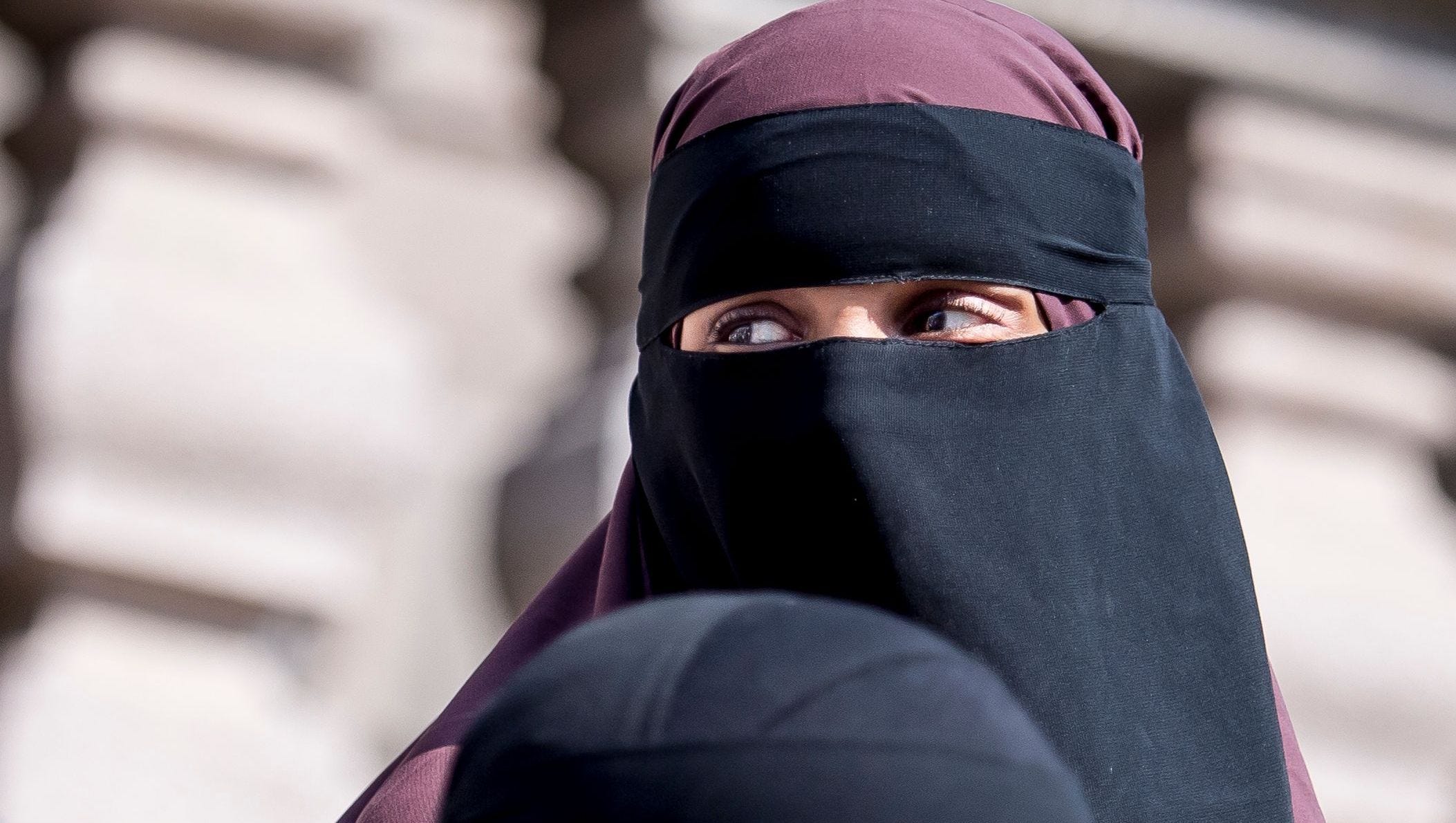The Burqa is an outer garment worn mainly by Muslim women to signify modesty. The exact history of the Burqa is not known. However, what is known is that it is mentioned in Islamic texts that men and women should always dress up moderately. However, covering the face and body with a veil is centuries old. It originates from the time when the invaders used to misuse their victories by imprisoning the women of their prisoners and taking them into their harem. Since then, women have been asked to cover themselves to preserve their modesty. The Islamic burqa is generally black, with the face fully covered, including the eyes. However, there are many variations to this, and one of them is used in the Arab World, which has a wire mesh on the nose to protect the veil from slipping.
Types of Burqa
The Burqa is not the only name or type available for Muslims to cover themselves. There is “Hijab” as well as “Niqab”. In Iran and Pakistan, there is “Chador”. As Islam spread through the world, it mixed local cultures with religious dictate. This brought many variations and names to local Muslim women’s external robes. Initially, the outer robe would be only black. However, variations came in color, shape, and size with time. Now, we have fashion shows in the Arab world that only showcase different colors, stitches, and details that the modest Burqa has undergone.
The burqa variations demonstrate Muslim women’s progress while still rooting in their traditions. Even the fabric of the Burqa has undergone a significant change. The initial heavy cotton material gave way to finer materials, including satin and silk.
History of Burqa
The Burqa has had a very chequered history. Many may not believe that centuries ago, women from all cultures and religions used to cover themselves fully with some robe to protect modesty. Many kingdoms forbade women from appearing in public with their faces uncovered. Women from the upper echelon of society, like queens and princesses, would not publicly show their faces. The beauty of women was a private domain. When Islam spread, the Islamic way of life or Sharia also spread rapidly. The Sharia dictated that the women should be covered head to toe with a black robe. That is how the Burqa came into our society. So, the history of the Burqa is older than even Islam. It was imposed through Sharia to ensure that society protects women in public.

There are different rules regarding wearing a burqa. It is a must while reading the holy book, the Quran. It is also a must during the childbearing stage, and women who do not menstruate need not wear it. Historians do not even agree that Islam brought the Burqa as an outer garment. Yes, there is evidence that it was made mandatory, and many countries had special police to monitor women wearing Burqa.
Cultural Significance
Culturally, Burqa is synonymous with Islam. A woman not wearing a Burqa is not respected in many Islamic countries. In Saudi culture, women must wear full Burqa while in public. Even in more moderate countries like Pakistan and Bangladesh, the women in public would cover their bodies with some loose-fitted cloth called Chador. As in Islam, culture and tradition go hand in hand, and so does the Burqa. Girls below 10 and women above 60 are exempt from wearing the Burqa. However, when women take up professional responsibilities, society slowly realizes that it is impossible always to wear the Burqa. More progressive countries like Egypt and Turkey have also abolished the use of the Burqa in their countries. In some Islamic countries, the Burqa is seen as a sign of orthodoxy, like in Turkmenistan, where the rulers strictly abolished the Burqa from their societies. Hence, as cultures change rapidly, even the use and design of the Burqa also change quickly.
Traditional Designs
Traditionally, the Burqa was made from a heavy cotton material called “Tabatel,” which is only available in India. However, the Burqa was stitched in different manners and for various purposes. The rich would have their Burqa lined with gold and some other expensive material, while the poor would always wear the same old style. The traditional design does not have many of the decorations and trinkets that the modern design has.
The Burqa’s color has always been black, but this has also changed. For instance, green burqas, known as ‘Abu Sarukh,’ red ones, called ‘Al-Nil,’ and yellow ones, known as ‘Abu Najma,’ are not just aesthetic choices but are imbued with cultural meanings and associations.
The traditional Burqa of the UAE and many GCC countries is called an Abaya. It is also a head-to-toe garment that is stitched differently. Even in the back, it has many traditional variations, like gold borders and particular motifs covered.
Making a burqa is a skill, often taking about an hour by hand, though modern machines can produce them much quicker. The key to crafting a burqa lies in the precise cutting and sewing of the fabric. Today, the Burqa is a personal garment and part of the UAE’s efforts to promote and preserve their heritage. It is distributed during festive occasions, used as souvenirs, and even incorporated into household decorations and accessories.
Therefore, Burqa’s design is not just about aesthetics; it reflects history, social status, and personal identity. It stands as a proud emblem of the cultural legacy of the Emirati people, representing values of modesty, humility, and a connection to their roots. As fashion continues to evolve, the traditional Burqa remains a significant and cherished part of the UAE’s cultural expression. The Burqa is a beautiful example of how fashion and tradition intertwine, creating a rich tapestry of cultural identity that is both preserved and celebrated in the modern world.
Regional Variations
The Burqa has many regional variations. It follows the wealth, richness, and traditions. The Burqa is more fashionable in certain African countries like Egypt, Algeria, and Morocco. It has a different cut and shape. Here, the Burqa is more tightly fitted. In GCC, the Burqa is making slow progress toward becoming more design-friendly. As women here can afford more expensive fabric, they go to famous designers to make beautiful and ornate burqas, which they wear during marriages and other important ceremonies.
The Burqa has become a fashion statement today, with designs and colors matching the latest trends. This blend of tradition and modernity reflects the dynamic nature of cultural practices and individuals’ personal choices.
However, the Burqa is still very traditional in more stringent Islamic countries. The rules, like the Taliban, fully forbid women from wearing any other design of Burqa apart from the traditional black robe that covers the women fully. The variations in burqa design based on the region highlight the rich tapestry of Islamic culture and the importance of understanding the context behind these traditional garments. Whether it’s the “Sabeel Cut” in Abu Dhabi or the narrow-shaped Burqa of Al Ain, each style carries its history and significance, contributing to the diverse cultural heritage of the Islamic world.
Modern Adaptations
As societies advance, more and more women join the workforce. They become doctors, join the military, and even play sports. In many professional avocations, it is tough to carry a heavy black robe, and it may endanger the lives of others. For a long time, voices came from both women and men that there should be some exemptions from wearing burqas at work.
This modern adaptation is not just about aesthetics; it’s also about functionality and comfort. Lightweight materials such as cotton and silk are being used to suit different climates and lifestyles, making the Burqa more adaptable to various environments and occasions.
Moreover, the modern Burqa is becoming a symbol of empowerment and individuality. Women choose styles that resonate with their personal beliefs and fashion sense, turning the Burqa into a statement of identity rather than just a symbol of tradition.
Modern adaptations also include variations in overall size. Arab male and female fashion designers are revolutionizing burqa designs for work, play, and even military activities.
The conversation around the modern Burqa is rich and ongoing, reflecting the diverse experiences and perspectives within the Muslim community. It is abundantly clear that the Burqa’s story is far from over; those who wear it with pride and purpose are constantly rewriting it. Exploring this journey offers a window into the creativity and resilience of a culture that values its heritage and its place in the modern world.
For a deeper dive into the transformative impact of the modern Burqa on women’s lives and its place in the fashion world, one may explore comprehensive guides and discussions illuminating modern Islamic fashion’s beauty and elegance. Whether through personal choice or collective evolution, the modern Burqa remains a vibrant and meaningful part of many lives, adapting and thriving in a changing world.
Religious Perspective
Since the ninth or tenth century, women have worn the Burqa in various Islamic cultures. It is an outer garment covering the body and face, typically leaving a mesh screen for the wearer to see. The practice of veiling can be traced back to pre-Islamic times and has been adopted in different forms across various cultures. History records prove that women in the Middle East and Asia used burqas or similar garments to ensure modesty and prevent attacks.

From a religious perspective, the Burqa is not universally seen as a mandatory Islamic practice. Most Islamic scholars, both past and present, do not regard face veiling as a religious requirement. However, a minority of scholars in Islamic jurisprudence consider it obligatory for Muslim women when in the presence of non-related males as a means to prevent men from looking at women with desire.
The Burqa is more than just a piece of clothing; it is a symbol with deep cultural significance. In some regions, it represents a woman’s commitment to her faith and community traditions. For others, it is a form of cultural expression, with variations in style, color, and design reflecting local customs and individual tastes.
In modern times, the Burqa has become a focal point in discussions about religious freedom, women’s rights, and cultural identity. Some view it as a symbol of oppression, while others see it as a personal choice and an expression of religious devotion. The debate is complex and often reflects broader societal issues surrounding integration, secularism, and multiculturalism.
Understanding the Burqa requires appreciating its multifaceted role in history, religion, and culture. It’s a garment that carries significant meaning for those who wear it and is a testament to the diversity of Islamic practices and beliefs. As with any cultural symbol, the Burqa is best understood not through a single lens but through a tapestry of historical, religious, and social threads that weave the rich fabric of Islamic heritage.
Social and Political Context
The Burqa has been at the forefront of many social and political narratives. In many non-Islamic countries, the political leadership likes to show their modern side by banning Burqa. In countries like France, wearing the Burqa in public places is banned. The Europeans see the Burqa as a stifling archaic practice that renders them helpless. They believe that women’s empowerment begins by throwing a bura altogether.
Socially, many countries believe that it demonstrates the backwardness of the society. Some also believe that it is both parochial and patriarchal. The context of the Burqa also arises from various divisions of Islam. Many moderate Muslims believe that the Burqa is not mandatory wear for women and should be imposed. The Burqa is one of the hottest topics in the world today.
Contemporary Debates
In Europe, the conversation around the Burqa and other forms of veiling has been ongoing for years. Several countries, including France, Belgium, Denmark, Austria, Latvia, and Bulgaria, have implemented bans on the fully covered Burqa in public spaces, often called ‘Burqa bans.’ The Human Rights Commission in Europe and America wants to remove the Burqa altogether as it links the Burqa with women’s empowerment. The debate is about the fundamental divide it creates between men and women. It says that men and women should choose what they want to wear.
However, the Middle East and West Africa present a different landscape for the burqa debate. In countries like Morocco, the government has banned the manufacturing and sale of burqas, citing security concerns and the spread of radical ideologies. This move reflects a tension between moderate Islamic governance and conservative religious practices. The debate here is also about national identity and the influence of foreign ideologies on local cultures.
Globally, the perspectives on the Burqa are diverse. Some see it as a symbol of oppression, while others view it as a personal and religious choice. The debate often reflects broader concerns about multiculturalism, integration, and the role of Islam in modern societies. It’s a complex issue that continues to evolve as societies grapple with the balance between individual freedoms and collective values.
The burqa debate is currently scorching and extreme. The hardcore Islamists strongly believe that Sharia should be allowed to prevail and women must always wear Burqa, no matter what.
Burqa Fashion and Style
The Burqa is now becoming a fashion statement. In many Islamic countries, it has also become a divider between rich and poor, modernity and tradition. It also follows education. Wherever the women are more educated, they want to have a say in wearing the Burqa, which integrates tradition with modernity.
Leading fashion designers have integrated their fashion with the Burqa, even for non-Islamic women. One of the Burqa’s most notable impacts on the fashion industry is the emergence of the ‘New Style Burqa,’ which has revolutionized the concept of Islamic fashion. This modern interpretation of the Burqa has introduced a variety of colors, patterns, and designs, moving away from the traditional black attire to a more vibrant and diverse palette.

Designers have taken inspiration from the Burqa’s silhouette and functionality, creating fashionable and modest garments. The Moroccan-style Burqa design, which is Kaftan-inspired, flatters all body types with clever layering and silhouettes. It’s adaptable to various fabrics and occasions, from everyday wear to luxurious events.
The influence of the Burqa is also seen in high-fashion circles. Designer burqas have appeared on fashion week runways, showcasing how traditional modest wear can be reimagined as a high-fashion statement. This has opened up conversations about cultural representation and the inclusivity of fashion.
Globally, the Burqa has become more wearable and acceptable clothing worn with pride. As fashion evolves, the Burqa remains a symbol of cultural identity and a source of inspiration for designers looking to merge tradition with modernity. The ongoing dialogue between traditional modest wear and contemporary fashion highlights the dynamic and ever-changing nature of the fashion industry.
Global Influence
Many high-street fashionistas, like Rehana and Naomi Campbell, have influenced not only the Burqa but also its design and acceptability. The Burqa’s influence extends beyond fashion and personal choice, touching on broader issues such as integration and multiculturalism. The burqa can be perceived as challenging these principles in societies that value secularism and uniformity. Conversely, the Burqa may be embraced as a norm in communities where religious expression is integral to social life.
Moreover, the Burqa’s global influence is not static; it evolves with the shifting tides of politics, social movements, and international relations. The rise of populist politics in some regions has led to its politicization, where it is used as a symbol to rally support for broader agendas concerning immigration and cultural preservation.
The conversation around the Burqa is also shaped by events that resonate worldwide. For instance, the COVID-19 pandemic highlighted the paradox in attitudes towards face coverings, contrasting mandatory mask policies with bans on religious veils. This situation has prompted reflections on the meanings and implications of different face coverings in public spaces.
In conclusion, the burqa style demonstrates its more extensive acceptance in society and multiculturalism. It is not limited to Muslim women only and is not only black. Women from many religions and cultures adopt it with pride.
Conclusion
The Burqa has come a long way since its origin in the early 10th century. Traditional designs have given way to modern designs that, while preserving women’s modesty, add a woman quotient.
The Burqa’s cultural significance is as deep-rooted as its religious association. Its ever-changing design also tells us that Muslim women are ready to embrace their religion with modernity. They have reworked the Burqa to suit their careers.
FAQs
What are the different styles of Burqa?
The Burqa has many styles.
Traditional Burqa is the most concealing of all Islamic veils, covering the entire face and body, often leaving just a mesh screen for women to see.
Boshiya: It is the Persian variation of the traditional Burqa. But it is even more conservative than the traditional Burqa.
Niqab: The niqab is worn in many countries. It is like a burqa but does not cover the whole face.
Half Niqab: Covers the lower half of the face up to the bridge of the nose, leaving the eyes and forehead clear.
How has the perception of the Burqa evolved?
As worn by traditional Muslim women, the Burqa carried a perception of traditional Islamic values. In many Islamic countries where the Burqa is not mandatory, the wearer carries more respect and power. However, the same governments are slowly accepting women without burqas or Muslim women wearing fashionable burqas. Hence, the perception is changing slowly.
What cultural and religious factors influence the wearing of a burqa?
Religiously, a woman wearing a burqa in an Islamic country commands immense respect. Culturally, the Burqa can symbolize various things depending on the region. In some areas, it may represent a form of patriarchal piety, while in others, it could signify personal freedom or suppression. The factors that influence Burqa are many. It starts with the home. A more traditional Islamic household where women are not allowed even to work outside has strict laws regarding wearing a burqa. Political leanings, education, and affluence are also very important factors.
In South Asia, for example, the practice of wearing a veil, known as purdah, is a middle-class phenomenon and is not practical for working-class women who perform laborious tasks. The Burqa and niqab have been subjects of debate, with opinions divided on whether they represent personal freedom or patriarchal control.

